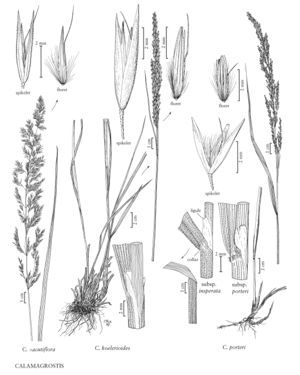Difference between revisions of "Calamagrostis porteri subsp. porteri"
FNA>Volume Importer |
imported>Volume Importer |
||
| (8 intermediate revisions by 2 users not shown) | |||
| Line 1: | Line 1: | ||
{{Treatment/ID | {{Treatment/ID | ||
|accepted_name=Calamagrostis porteri subsp. porteri | |accepted_name=Calamagrostis porteri subsp. porteri | ||
| − | |accepted_authority= | + | |accepted_authority= |
|publications= | |publications= | ||
|basionyms= | |basionyms= | ||
| Line 15: | Line 15: | ||
-->{{Treatment/Body | -->{{Treatment/Body | ||
| − | |discussion=<p>Calamagrostis porteri subsp. porteri grows from New York to Virginia, Tennessee, and Kentucky. One specimen from Claiborne County, Tennessee, lacks hairs around the collar, but the leaves are glaucous on both surfaces. There are other specimens from this county that have hairy collars.</p><!-- | + | |discussion=<p><i>Calamagrostis porteri </i>subsp.<i> porteri</i> grows from New York to Virginia, Tennessee, and Kentucky. One specimen from Claiborne County, Tennessee, lacks hairs around the collar, but the leaves are glaucous on both surfaces. There are other specimens from this county that have hairy collars.</p><!-- |
| − | --><p>Calamagrostis porteri subsp. porteri appears to form hybrids with the nearly sympatric C. canadensis (p. 726) in rocky wooded sites in central Virginia. These putative hybrids have hairy collars, relatively long callus hairs, and short awns.</p> | + | --><p><i>Calamagrostis porteri </i>subsp.<i> porteri</i> appears to form hybrids with the nearly sympatric <i>C. canadensis</i> (p. 726) in rocky wooded sites in central Virginia. These putative hybrids have hairy collars, relatively long callus hairs, and short awns.</p> |
|tables= | |tables= | ||
|references= | |references= | ||
| Line 25: | Line 25: | ||
-->{{#Taxon: | -->{{#Taxon: | ||
name=Calamagrostis porteri subsp. porteri | name=Calamagrostis porteri subsp. porteri | ||
| − | + | |authority= | |
| − | |authority= | ||
|rank=subspecies | |rank=subspecies | ||
|parent rank=species | |parent rank=species | ||
| Line 32: | Line 31: | ||
|basionyms= | |basionyms= | ||
|family=Poaceae | |family=Poaceae | ||
| + | |illustrator=Cindy Roché;Hana Pazdírková | ||
| + | |illustration copyright=Utah State University | ||
|reference=None | |reference=None | ||
|publication title= | |publication title= | ||
|publication year= | |publication year= | ||
|special status= | |special status= | ||
| − | |source xml=https:// | + | |source xml=https://bitbucket.org/aafc-mbb/fna-data-curation/src/200273ad09963decb8fc72550212de541d86569d/coarse_grained_fna_xml/V24/V24_1021.xml |
|subfamily=Poaceae subfam. Pooideae | |subfamily=Poaceae subfam. Pooideae | ||
|tribe=Poaceae tribe Poeae | |tribe=Poaceae tribe Poeae | ||
Latest revision as of 16:21, 11 May 2021
Culms (60)75-100 cm. Sheaths smooth or slightly scabrous; collars usually with prominent tufts of hair, rarely glabrous; ligules (1)2-5(6) mm; blades 8-40 cm long, (2)3-6(8) mm wide, abaxial surfaces darker green than the adaxial surfaces, adaxial surfaces light green, glaucous. Panicles (5)10-12(15) cm long, 0.8-3(7) cm wide; branches (1.5)2-5 cm. Spikelets 4-5 mm; rachilla prolongations with 1.5-2(3.5) mm hairs. Callus hairs 1.5-2 mm, 0.4-0.6 times as long as the lemmas; lemmas 3.5-4.5 mm, 0.5-1.5 mm shorter than the glumes; awns 3-4(4.5) mm, attached to the lower 1/10 – 1/5 of the lemmas; anthers about 2 mm. 2n = 84-±104.
Discussion
Calamagrostis porteri subsp. porteri grows from New York to Virginia, Tennessee, and Kentucky. One specimen from Claiborne County, Tennessee, lacks hairs around the collar, but the leaves are glaucous on both surfaces. There are other specimens from this county that have hairy collars.
Calamagrostis porteri subsp. porteri appears to form hybrids with the nearly sympatric C. canadensis (p. 726) in rocky wooded sites in central Virginia. These putative hybrids have hairy collars, relatively long callus hairs, and short awns.
Selected References
None.
